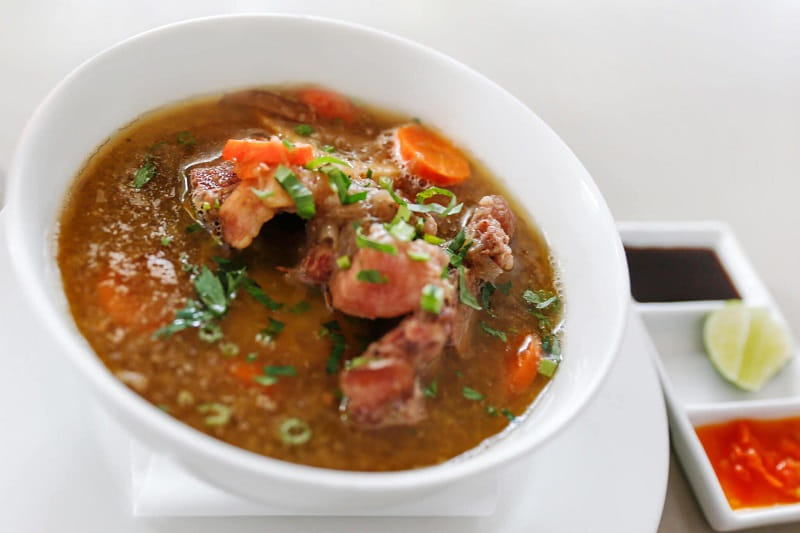Today, we delve into one of the most comforting and nourishing dishes known to humanity: beef soup bones. From their flavorful essence to their rich collagen, these beef soups are a staple ingredient that transforms ordinary broths into hearty, soul-satisfying soups. Join us as we unravel the secrets behind these sought-after culinary gems and discover the countless ways they can elevate your dining experience.
The Benefits Of Using Beef Soup Bones In Soups And Stews
- Enhanced flavor: It adds a rich, meaty flavor to soups and stews that are unmatched by any other ingredient. The bones release collagen, gelatin, and marrow during cooking, imparting a delicious depth and complexity to the dish.
- Nutritional value: They are a great source of calcium, magnesium, phosphorus, and potassium, vital for strong bones, teeth, and overall health. These bones also contain collagen, a protein that supports joint health and improves digestion.
- Economical choice: They are usually less expensive than meat cuts and can be simmered for hours to extract every bit of flavor and nutrients.
- Waste reduction: Instead of discarding bones, you can repurpose them and extract all their goodness, making the most of every part of the animal.
- Versatility: You can make bone broth, a nutrient-dense and healing beverage, or use the bones as a base for sauces, gravies, and risottos. The possibilities are endless!
- Comfort and satisfaction: The rich aroma and hearty flavors can provide warmth and satisfaction, making them the perfect comfort food on a chilly day.

The Difference Between Grass-Fed And Conventionally Raised Beef Soup Bones
Regarding beef soup bones, there is a significant difference between grass-fed and conventionally raised options. Let me break it down for you.
Grass-fed beef bones come from cattle raised on a natural grass and forage diet. These animals roam freely and graze on nutrient-rich pastures, producing leaner and more flavorful meat. Grass-fed beef is also higher in key nutrients such as omega-3 fatty acids and antioxidants.
On the other hand, conventionally raised beef bones come from cattle that are typically raised in feedlots and fed a diet of grain and corn. These animals may be given antibiotics and growth hormones to promote rapid weight gain. As a result, conventionally raised beef can contain higher levels of saturated fats and fewer beneficial nutrients than grass-fed beef.
In terms of taste, grass-fed beef bones offer a rich, beefy flavor that is robust and satisfying. The meat tends to have a firmer texture and a deeper color. Conventionally raised beef, on the other hand, might have a milder flavor and a softer texture due to the higher fat content.
Regarding health benefits, grass-fed beef soup bones are the clear winner. They contain higher levels of heart-healthy fats, essential vitamins, and minerals and are free from antibiotics and growth hormones. Choosing grass-fed beef bones supports your health and promotes sustainable and ethical farming practices.
Tips And Tricks For Cooking With Beef Soup Bones
- Choose the Right Cut: When selecting beef bones for cooking soup, opt for cuts with high collagen content, such as marrow or knuckle bones. These cuts will impart a rich flavor and velvety texture to your soup.
- Roast the Bones: Before adding the bones to your soup, roast them in the oven. This step enhances the flavor by caramelizing the meat and adding depth to the broth.
- Simmer: To extract the maximum flavor, simmer them. Aim for a low and gentle simmer, rather than a rapid boil, for at least 4-6 hours. You can also use a slow cooker or pressure cooker for convenience.
- Add Aromatics: Add aromatic vegetables and herbs to enhance the soup’s flavor profile. Onions, celery, carrots, garlic, and bay leaves are common additions that can elevate the taste of your broth.
- Skim the Fat: Fat may surface as the soup simmers. Skim off this excess fat using a spoon or ladle to achieve a cleaner and healthier broth.
- Strain the Broth: Once the soup is ready, strain the broth to remove any bones, vegetables, and impurities. This step ensures a smooth and clear soup, allowing the flavors to shine.
- Add Additional Ingredients: After straining, add additional ingredients to customize your beef soup. Add cooked meat, vegetables, noodles, or herbs to create a hearty and satisfying meal.
- Store and Reuse: If you have leftover soup, store them in the refrigerator for up to three days or freeze them for future use. The bones can be reused to make another batch of flavorful broth or as a base for other dishes like risotto or sauces.
Read more:
Tips For Properly Storing And Handling Beef Soup Bones

Proper Storage: After using soup, storing it correctly is essential to maintain its quality. Allow the bones to cool completely before refrigerating or freezing. If stored in the refrigerator, wrap them tightly in plastic wrap or an airtight container to prevent odors from contaminating other foods. For long-term storage, freezing is the best option. Wrap the bones well in plastic wrap and then place them in a freezer bag or airtight container. This will prevent freezer burn and maintain their flavor for up to three months.
Label and Date: Label and date your stored soup bones to avoid confusion. This will help you track how long they have been in the refrigerator or freezer. Use a permanent marker or freezer-safe labels to mark the storage date clearly.
Proper Defrosting: When you’re ready to use your frozen soup, it’s important to thaw it properly to maintain its texture and flavor. The best method is to transfer them from the freezer to the refrigerator and allow them to thaw overnight. This slow thawing process ensures that the bones defrost evenly and safely.
Safe Handling: Proper food safety is crucial when handling soup. Always wash your hands thoroughly with soap and warm water before and after handling the bones. This will prevent the spread of bacteria.
The Nutritional Value Of Beef Soup Bones
These soup bones are flavorful and delicious and offer several nutritional benefits. When simmered for an extended period, they release their rich flavor and nutrients into the broth, making it a highly nutritious addition to your soups and stews.
One of the key nutrients found in soup is collagen. Collagen is a protein that provides structure and support to our skin, bones, tendons, and ligaments. Consuming collagen-rich foods like beef soup bones can help promote joint health and may even improve joint pain and stiffness.
It is also a great source of minerals such as calcium, magnesium, and phosphorus, which are essential for maintaining strong and healthy bones. These minerals contribute to bone density and can help prevent conditions like osteoporosis.
Additionally, these soup bones contain gelatin, a protein that supports healthy digestion. Gelatin helps to strengthen the lining of the digestive tract and can aid in treating leaky gut syndrome and other digestive disorders.
Furthermore, beef bones are a rich source of amino acids, which are the building blocks of protein. Amino acids are crucial in muscle repair and growth and support a healthy immune system.
It’s important to note that the nutritional value of beef soup bones can vary depending on factors such as the type of bones used, cooking time, and additional ingredients added to the broth. However, regardless of these variables, incorporating beef bones into your diet can provide a range of essential nutrients that contribute to overall health and well-being.
Beef Soup Bones Recipe

Ingredients
- 3 pounds of beef neck bones
- 3 tablespoons of olive oil
- 2 heads of garlic
- Foil (for covering)
- 1 large onion
- 2 stalks of celery
- Fresh ground black pepper
- Tomato puree (desired amount)
- Salt (to taste)
- Fresh thyme (tied with a string)
- 2 thick pieces of ginger
- 1 scotch bonnet pepper
- 5 large carrots
- 5 potatoes
- Pieces of pumpkin
- Small cabbage
- Fresh parsley (for garnish)
Instructions
- Preheat the oven to 375 degrees.
- Combine the beef neck bones, olive oil, and whole heads of garlic in a baking dish.
- Mix well, then lightly cover with foil.
- Roast in the oven for one hour.
- Remove from the oven and set aside.
- In a large pot, heat the olive oil on medium-low heat.
- Add the onion and sauté until coated with the beef drippings.
- Add the celery and fresh ground black pepper. Mix well.
- Remove the roasted garlic cloves from their skins and add them to the pot.
- Add the tomato puree and mix well.
- Add the beef neck bones to the pot, along with any pan drippings.
- Add salt and fresh thyme, tied with a string for easy removal later.
- Add the ginger and scotch bonnet pepper to the pot. (Optional: remove the pepper later for less heat)
- Pour in hot water to cover all the ingredients in the pot.
- Bring the mixture to a boil, then reduce it to a rolling boil.
- Allow it to simmer for approximately 25-30 minutes.
- Add the carrots, potatoes, pieces of pumpkin, and cabbage to the pot.
- Continue simmering until the potatoes and pumpkin are tender.
Adjust the seasoning with salt if needed. - Remove the thyme sprigs, ginger pieces, and scotch bonnet pepper (if desired).
- Serve the beef soup bones hot, garnished with fresh parsley.
- Enjoy this light and flavorful beef soup, full of rich broth and tender meat. Serve with crusty bread or your favorite side dish. Don't forget to savor the delicious flavors and aromas!

Hey readers! Chip Holland here, and I’m a Manager of this website. My passion for writing about it only matches my passion for BBQ. Follow my blog for mouth-watering recipes, tips, and tricks for the perfect smoke, grill, and BBQ. I’m sure you won’t be disappointed!
